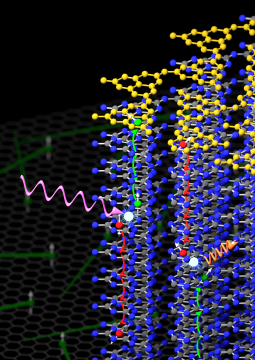Press Releases
| Helmholtz-Zentrum Berlin, Science Highlight 05.06.2019 Organic electronics: a new semiconductor in the carbon-nitride family Teams from Humboldt-Universität and the Helmholtz-Zentrum Berlin have explored a new material in the carbon-nitride family. Triazine-based graphitic carbon nitride (TGCN) is a semiconductor that should be highly suitable for applications in optoelectronics. Its structure is two-dimensional and reminiscent of graphene. Unlike graphene, however, the conductivity in the direction perpendicular to its 2D planes is 65 times higher than along the planes themselves. |
 | Free University Berlin, PR 358/2015, Nov 12, 2015 New Class of Materials for Organic Electronics Joint Project Details Charge Transport in Polymeric Carbon Nitride for First Time
Polymeric carbon nitride is an organic material with interesting optoelectronic properties. As an inexpensive photocatalyst, it can be used to facilitate water splitting using sunlight. Joint research by Helmholtz-Zentrum Berlin, the University of Rostock, and Freie Universität Berlin as well as other partners has now investigated for the first time how light creates charge carriers in this class of materials and established details about charge mobility and lifetimes. They discovered surprising characteristics in their investigations that provide prospects for new applications, in conjunction with graphene for example. |
Videos
 | Helmholtz-Zentrum Berlin Hydrogen produced with light HZB researchers have developed a new semiconducting structure, which uses sunlight to split water and produce hydrogen. It is made from a substrate of Chalcopyrite, coated with Titaniumdioxide, both inexpensive materials. See, how this structure is produced. The research is embedded in the program Light2hydrogen, sponsored by the German Ministry for Education and Research (BMBF).
See the video on YouTube: |
